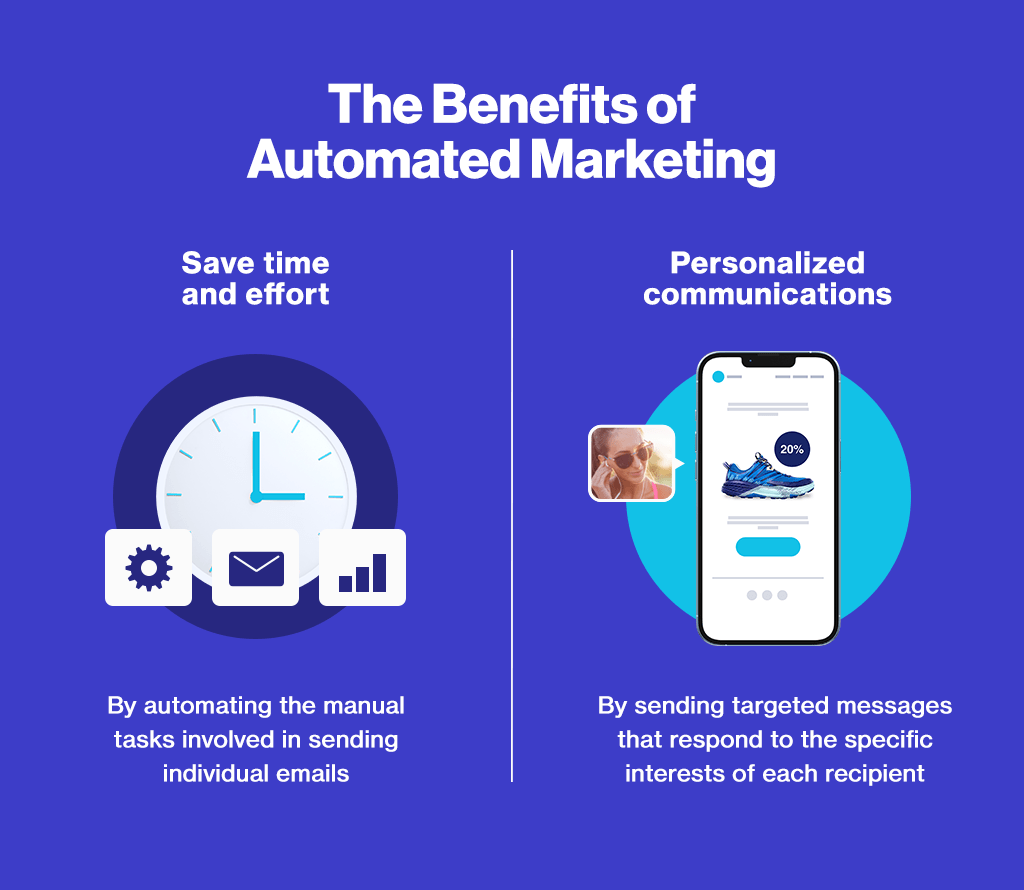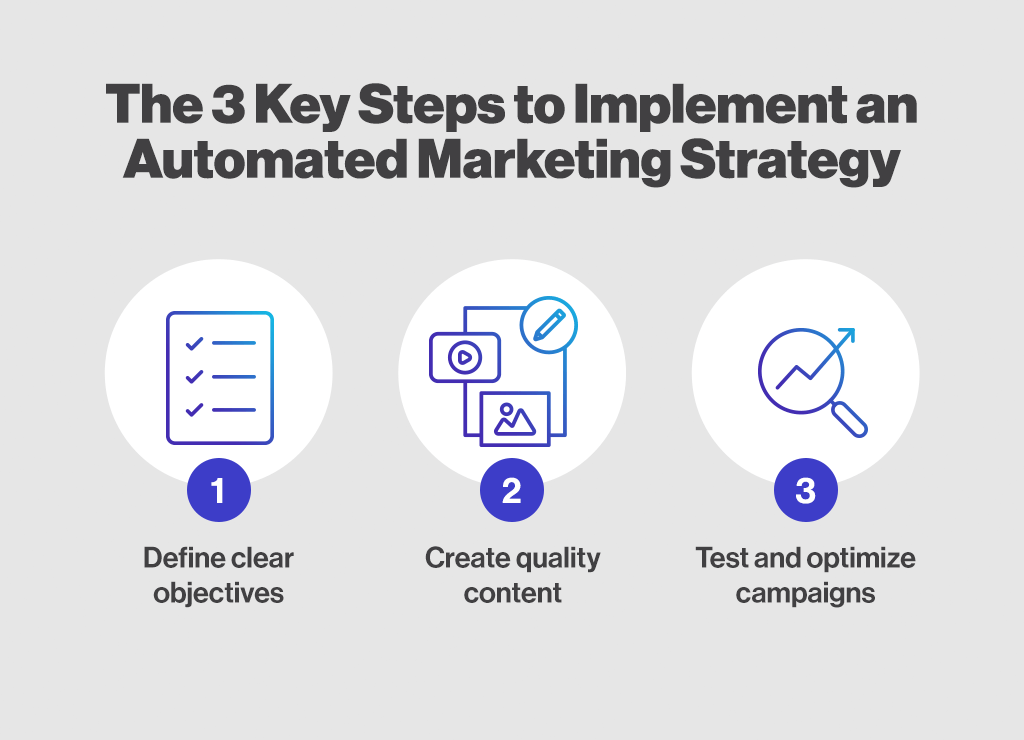Email marketing automation has become an essential strategy for online businesses. In a world where productivity is crucial, this approach offers significant benefits in terms of time, efficiency, and personalized communication. By automating repetitive tasks associated with emails, businesses can free up valuable resources to focus on other aspects of their operations.
This article will delve into detail on how email marketing automation can boost your productivity and help you achieve your business goals faster and more efficiently.
The benefits of email marketing automation
There are numerous benefits to email marketing automation. Here are a few to consider.

Time and effort savings
Email marketing automation offers numerous benefits, and one of the first and most obvious ones is the time and effort savings it provides. By automating manual tasks associated with sending individual emails, businesses can optimize their operational efficiency and allocate their resources to higher-value activities.
Reducing the manual task of sending individual emails is one of the most valued aspects of automation. Instead of spending time manually composing and sending emails to each recipient, businesses can utilize automation tools to send mass emails to their entire contact list. This saves valuable time and reduces potential errors associated with manually entering email addresses.
Moreover, email marketing automation allows for the scheduling of campaigns in advance. Instead of worrying about sending messages at the right time, businesses can plan their campaigns ahead of time and automate them to be sent at the most relevant moments.
For example, you can schedule the sending of a promotional email to coincide with a special sales period or to send birthday wishes to a customer. This functionality allows for optimizing the best timing to send a communication and enhancing recipient engagement.
Personalization of communications
By leveraging customer data, businesses can send targeted messages that cater to the specific needs and interests of each recipient.
The use of customer data is crucial for effective personalization of email communications. By collecting and analyzing information on customer preferences, purchasing behavior, and past interactions, businesses can tailor their messages based on this data.
For example, if a customer has previously purchased a specific product, email marketing automation allows for sending subsequent messages offering complementary products or special offers related to that previous purchase. This targeted approach enhances message relevance and promotes recipient engagement.
Another key feature of email marketing automation is the ability to segment subscriber lists based on preferences and behaviors. Instead of sending the same message to all subscribers, businesses can create specific segments by grouping recipients who share similar characteristics.
For example, a clothing company can segment its subscriber list based on gender, age, or style preferences. They can then send specific emails to each segment, recommending products that align with the tastes and needs of each group. This approach increases message relevance and enhances the chances of conversion.

In addition to segmentation, email personalization is another key advantage of email marketing automation. With advanced features, businesses can automatically insert personalized elements such as the recipient’s name, product recommendations based on purchase history, exclusive offers, or recipient-specific information.
This gives an impression of individual communication and enhances recipient engagement with the brand. Personalized emails are more likely to be opened, read, and lead to actions such as purchases or sign-ups.
Fun fact, “the most effective strategies for email marketing campaigns are subscriber segmentation (78%), message personalization (72%), and email automation campaigns (71%)” – Source : Hubspot 2021
Improving the efficiency of marketing campaigns
Improving the efficiency of marketing campaigns is a major goal for online businesses. Email marketing automation plays a key role in this aspect, offering significant advantages in terms of tracking results, data analysis, and strategy optimization.
Tracking and analyzing results
Tracking and analyzing results are essential elements of any marketing campaign. Automated marketing provides advanced tools that allow for precise and detailed measurement and analysis of performance. These features provide businesses with valuable insights to improve their future campaigns and optimize their effectiveness.
The use of automation tools allows for measuring email open rates, click-through rates, and conversion rates. These metrics provide insights into how recipients are responding to the sent newsletters.
For example, the open rate indicates how many recipients have opened the email, the click-through rate measures how many recipients have clicked on the links included in the email, and the conversion rate represents the percentage of recipients who have taken a specific action, such as making a purchase or signing up. These data help understand the effectiveness of the campaign and identify areas for improvement.
Once the data is collected, analysis plays a key role in improving future campaigns. By examining the results, businesses can identify trends, preferences, and recipient behaviors.
For example, by analyzing clicks on different links within an email, a company can determine which products or offers generate the most interest among recipients. This in-depth analysis enables informed decision-making to adjust marketing strategies and maximize the chances of success.
Sales process automation
Email marketing automation also offers valuable benefits in terms of sales process automation. By creating automated sales funnels, businesses can effectively and personalized guide prospects through the purchasing process.
The creation of automated sales funnels allows for the planning and implementation of strategically designed email sequences to accompany prospects at every stage of the buying journey.
When a prospect subscribes to a mailing list, a series of automated emails can be scheduled to provide them with additional information about the products or services offered.
As the prospect progresses through the sales funnel, the emails can be tailored to address their specific needs and encourage them to take action, whether it’s making a purchase, requesting a quote, or scheduling a demo.
This automation helps to maintain the engagement of potential customers and effectively guide them throughout the buying process.
Sending follow-up emails is another essential feature of automated marketing in the context of sales processes. After a prospect takes a specific action, such as downloading a whitepaper or adding a product to the cart, automation can be set up to send a relevant follow-up email.
These messages can provide additional information, offer special promotions, or encourage the prospect to make a purchase. The goal is to maintain the prospect’s interest and engagement by providing them with the necessary information to make an informed decision.
Email marketing automation enables the identification of highly qualified leads. By tracking prospects’ interactions with emails and analyzing the data, companies can assess the level of engagement and interest from prospects.
If a prospect has opened and clicked on multiple emails and visited several pages on the website, it indicates a high level of interest. Automation can trigger immediate alerts or business actions, such as a phone call from a sales representative or sending a special offer to convert the prospect into a customer.
Best practices for effective email marketing automation
To fully leverage automation, it is essential to have a solid strategy in place and follow best practices. Here are the key steps to plan, implement, and optimize your automated marketing to maximize results and achieve your marketing goals.

1. Set clear objectives
Identify specific goals you aim to achieve through email marketing automation. These may include:
- Increasing sales
- Generating qualified leads
- Enhancing customer engagement
- Improving customer retention
- Promoting specific products.
Each goal should be specific and measurable, allowing you to track your progress and evaluate the results achieved.
It’s also important to align your email marketing automation campaigns with the overall business objectives of your company. If your goal is to increase sales, your campaigns should focus on generating qualified leads and converting prospects into customers. If you aim to improve customer retention, your campaigns should concentrate on engaging existing customers and promoting exclusive offers.
By setting clear goals and aligning them with your business objectives, you create a clear vision of what you want to achieve with email marketing automation. This will enable you to plan and implement strategic campaigns that directly contribute to the growth of your business.
2. Create high-quality content
It is crucial to create high-quality content that captivates recipients and motivates them to take the desired action. Well-crafted content is essential for engaging your audience and achieving optimal results from your campaigns.
When creating automated emails, ensure they are relevant and appealing to the recipients. Each communication should provide added value and address the needs and interests of your target audience. Use catchy headlines, clear and concise text, appealing images, and compelling call-to-action (CTA) buttons to encourage recipients to take action.
It is also important to ensure that your content is tailored to different devices and platforms. Make sure your emails are optimized for easy reading on desktop computers, smartphones, and tablets. Recipients should be able to view and interact with your content seamlessly, regardless of the device they are using.
Don’t forget to include relevant links (URLs) in your emails to direct recipients to specific pages on your website. Whether it’s for making a purchase, downloading a guide, or signing up for an event, the links should be clear and easily identifiable.
3. Test and optimize campaigns
Testing and optimizing automation campaigns are essential steps to continuously improve your results. By conducting A/B tests, you can measure the effectiveness of different elements such as:
- The subject lines,
- The calls to action (CTA),
- The content,
- The timing of sending.
A/B testing involves sending two slightly different versions of the same email to segments of your subscriber list and measuring the performance of each version.
For example, you can test two different subject lines to see which one generates the highest open rate. You can also test different calls to action to determine which one generates the most clicks.
A/B testing allows you to gather concrete data on what works best with your audience and optimize your campaigns accordingly.
When conducting A/B tests, make sure to only modify one element at a time to measure its specific impact. If you are testing subject lines, keep the rest of the email unchanged to obtain clear results on the influence of the subject line alone.
Once you have collected data from your A/B tests, use that information to optimize your campaigns. Identify the elements that have generated the best results and incorporate them into your future campaigns.
If you found that a certain call-to-action wording achieved a high click-through rate, use that wording in other communications. Similarly, if you have identified a better time for sending your newsletters, adjust your scheduling accordingly.
Conclusion
In conclusion, email marketing automation is a powerful solution to enhance your productivity and optimize your online marketing efforts. By freeing you from manual and time-consuming tasks, it allows you to allocate your time and resources to higher-value activities.
